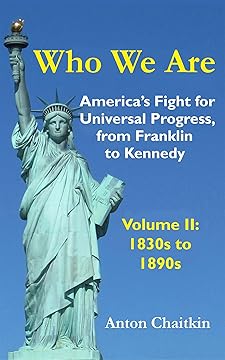Who We Are: America’s Fight for Universal Progress, From Franklyn to Kennedy Volume II 1830s-1890s
By Anton Chaitkin (2025)
Book Review
(Part 2)
Volume II of Who We Are covers the post-Civil War Reconstruction in far more detail than most schools and universities
Following Lincoln’s assassination in 1865, former slave owner Vice President Andrew Johnson became president. The latter was a Southern Democrat who ran with Lincoln on the National Union Party ticket in the 1864 election. One of his first acts was to issue a blanket pardon to all lower Confederate officers, to allow them to resume their seats in the Republican-controlled Congress. In response, House Republican leader Thaddeus Stevens sponsored a successful bill to call a joint Senate-House committee, which required the former Confederate states to call biracial conventions to choose new representatives to the House and Senate. It was a slow process, and it wasn’t until 1870 that the final four states (Virginia, Mississippi, Texas and Georgia) were readmitted to the Union.
Concerned about Southern black codes and Jim Crow laws being used to jail freed slaves, Stevens also introduced the 14th Amendment (in 1866). It explicitly grants citizenship to all persons born in the US.
After a New Orleans police-sanctioned mob broke up a Louisiana voting convention and burned the homes of Black participants, Stevens also introduced the 1867 Military Reconstruction Act. The new law deployed Union troops to keep the peace in the South.
Determined to resist Southern industrialization (which Republicans viewed as essential to provide jobs for freed slaves with no property or educations), New York and Boston bankers and entrepreneurs colluded with British interests to establish the “free trade” branch of the Republican party. Determined to retain the Southern plantations, using freed Blacks as cheap labor, they also deliberately created an economic crisis by drastically reducing the money supply. .
Running as a Republican, General Ulysses Grant easily won the 1968 election, as federal troops still protected Black voting right several former Confederate states were still excluded from voting.
In 1869, the Grant administration filed The Alabama Claims, demanding damages from the United Kingdom for the naval vessels Britain provided the Confederacy. After international arbitration (in Geneva) endorsed the claim in 1872, Britain settled by paying the United States government $15.5 million.
Neglected under Johnson, Philadelphia railroad expansion flourished under the pro-industrialist Grant. In 1869, the transcontinental railroad begun by Lincoln was completed. In 1870 a Philadelphia-based company built a rail network joining the North and South, hoping to stimulate Southern industrialization.* For similar reasons The Texas-Pacific Railroad completed a railroad line to Texas and San Diego. The Northern Pacific Railroad extended the railroad to Seattle the same year.
In 1876, Neither D Samuel Tilden nor Rutherfood Hayes received a majority of votes, so the presidential election was decided in the House. Southern Democrats who were pre-war Whigs (and supported industrialization) agreed to vote for Hayes provided the Republican leadership agreed to withdraw troops from the South and subsidize the extension of the Texas-Pacific Railroad into their districts.
The withdrawal of federal troops effectively ended Reconstruction.
*James A Roosevelt, the father of Franklin, was president of the Southern Railway Security Company.
Click this link for the original source of this article.
Author: stuartbramhall
This content is courtesy of, and owned and copyrighted by, https://stuartbramhall.wordpress.com and its author. This content is made available by use of the public RSS feed offered by the host site and is used for educational purposes only. If you are the author or represent the host site and would like this content removed now and in the future, please contact USSANews.com using the email address in the Contact page found in the website menu.








